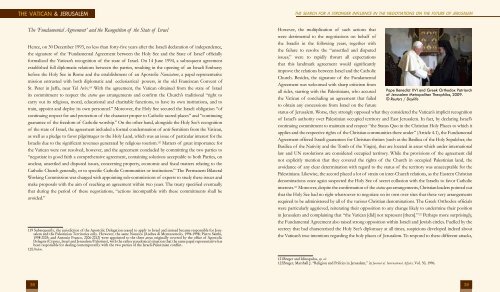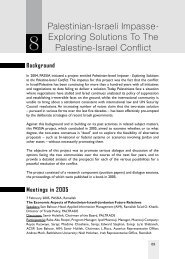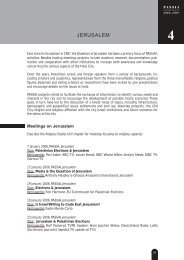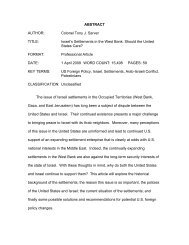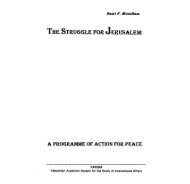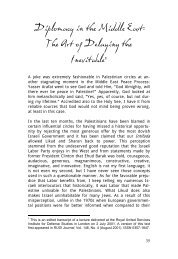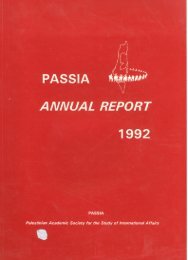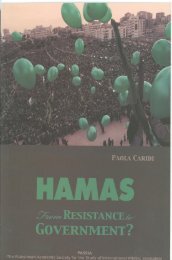The VaTican & Jerusalem - PASSIA Online Store
The VaTican & Jerusalem - PASSIA Online Store
The VaTican & Jerusalem - PASSIA Online Store
Create successful ePaper yourself
Turn your PDF publications into a flip-book with our unique Google optimized e-Paper software.
<strong>The</strong> Vatican & <strong>Jerusalem</strong><strong>The</strong> Search for a Stronger Influence in the Negotiations on the Future of <strong>Jerusalem</strong><strong>The</strong> ‘Fundamental Agreement’ and the Recognition of the State of IsraelHence, on 30 December 1993, no less than forty-five years after the Israeli declaration of independence,the signature of the ‘Fundamental Agreement between the Holy See and the State of Israel’ officiallyformalized the Vatican’s recognition of the state of Israel. On 14 June 1994, a subsequent agreementestablished full diplomatic relations between the parties, resulting in the opening of an Israeli Embassybefore the Holy See in Rome and the establishment of an Apostolic Nunciature, a papal representativemission entrusted with both diplomatic and ecclesiastical powers, in the old Franciscan Convent ofSt. Peter in Jaffa, near Tel Aviv. 119 With the agreement, the Vatican obtained from the state of Israelits commitment to respect the status quo arrangements and confirm the Church’s traditional “right tocarry out its religious, moral, educational and charitable functions, to have its own institutions, and totrain, appoint and deploy its own personnel.” Moreover, the Holy See secured the Israeli obligation “ofcontinuing respect for and protection of the character proper to Catholic sacred places” and “continuingguarantee of the freedom of Catholic worship.” On the other hand, alongside the Holy See’s recognitionof the state of Israel, the agreement included a formal condemnation of anti-Semitism from the Vatican,as well as a pledge to favor pilgrimages to the Holy Land, which was an issue of particular interest for theIsraelis due to the significant revenues generated by religious tourism. 120 Matters of great importance forthe Vatican were not resolved, however, and the agreement concluded by committing the two parties to“negotiate in good faith a comprehensive agreement, containing solutions acceptable to both Parties, onunclear, unsettled and disputed issues, concerning property, economic and fiscal matters relating to theCatholic Church generally, or to specific Catholic Communities or institutions.” <strong>The</strong> Permanent BilateralWorking Commission was charged with appointing sub-commissions of experts to study these issues andmake proposals with the aim of reaching an agreement within two years. <strong>The</strong> treaty specified eventuallythat during the period of these negotiations, “actions incompatible with these commitments shall beavoided.”119 Subsequently, the jurisdiction of the Apostolic Delegation ceased to apply to Israel and instead became responsible for <strong>Jerusalem</strong>and the Palestinian Territories only. However, the same Nuncios (Andrea di Montezemolo, 1994-1998; Pietro Sambi,1998-2005; and Antonio Franco, 2006-2012) were appointed to the three areas originally covered by the office of ApostolicDelegate (Cyprus, Israel and <strong>Jerusalem</strong>/Palestine), with the rather paradoxical situation that the same papal representative hasbeen responsible for dealing contemporarily with the two parties of the Israeli-Palestinian conflict.120 Ibidem.However, the multiplication of such actions thatwere detrimental to the negotiations on behalf ofthe Israelis in the following years, together withthe failure to resolve the “unsettled and disputedissues,” were to rapidly thwart all expectationsthat this landmark agreement would significantlyimprove the relations between Israel and the CatholicChurch. Besides, the signature of the FundamentalAgreement was welcomed with sharp criticism fromall sides, starting with the Palestinians, who accusedthe Vatican of concluding an agreement that failedto obtain any concessions from Israel on the futurePope Benedict XVI and Greek Orthodox Patriarchof <strong>Jerusalem</strong> Metropolitan <strong>The</strong>ophilos, 2009.© Reuters / Daylifestatus of <strong>Jerusalem</strong>. Worse, they strongly opposed what they considered the Vatican’s implicit recognitionof Israel’s authority over Palestinian occupied territory and East <strong>Jerusalem</strong>. In fact, by declaring Israel’scontinuing commitment to maintain and respect “the Status Quo in the Christian Holy Places to which itapplies and the respective rights of the Christian communities there under” (Article 4.1), the FundamentalAgreement offered Israeli guarantees for Christian shrines (such as the Basilica of the Holy Sepulcher, theBasilica of the Nativity and the Tomb of the Virgin), that are located in areas which under internationallaw and UN resolutions are considered occupied territory. While the provisions of the agreement didnot explicitly mention that they covered the rights of the Church in occupied Palestinian land, theavoidance of any clear determination with regard to the status of the territory was unacceptable for thePalestinians. Likewise, the accord placed a lot of strain on inter-Church relations, as the Eastern Christiandenominations once again suspected the Holy See of secret collusion with the Israelis to favor Catholicinterests. 121 Moreover, despite the confirmation of the status quo arrangements, Christian leaders pointed outthat the Holy See had no right whatsoever to negotiate on its own over sites that these very arrangementsrequired to be administered by all of the various Christian denominations. <strong>The</strong> Greek Orthodox officialswere particularly aggrieved, reiterating their opposition to any change likely to undermine their positionin <strong>Jerusalem</strong> and complaining that “the Vatican [did] not represent [them].” 122 Perhaps more surprisingly,the Fundamental Agreement also raised strong opposition within Israeli and Jewish circles. Fuelled by thesecrecy that had characterized the Holy See’s diplomacy at all times, suspicions developed indeed aboutthe Vatican’s true intentions regarding the holy places of <strong>Jerusalem</strong>. To respond to these different attacks,121 Breger and Idinopulos, op. cit.122 Breger, Marshall J. “Religion and Politics in <strong>Jerusalem</strong>,” in Journal of International Affairs, Vol. 50, 1996.38 39


